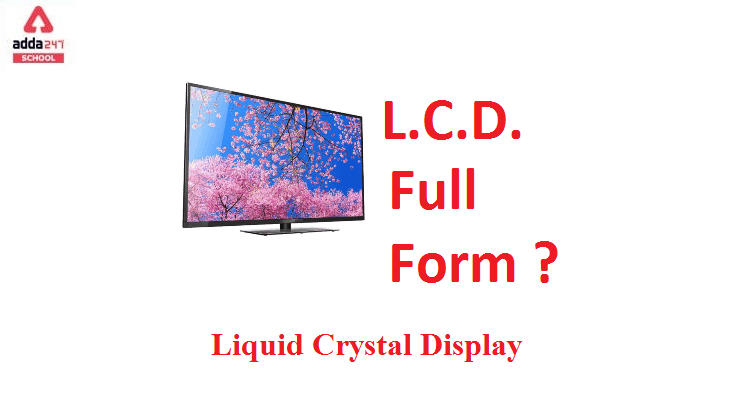Table of Contents
LCD full form: overview
LCD Full Form: LCD the abbreviation is liquid crystal display.
A flat panel display is a liquid-crystal display. When compared to the cathode ray tube (CRT) technology, LCD displays are substantially thinner. It might also be any other electronically modulated optical device that takes advantage of the light-modulating characteristics of liquid crystals and polarizers. Liquid crystals do not directly emit light. Instead, they’ll be employing a backlight or reflector to create colour or monochrome images. LCDs may display arbitrary images, as well as fixed images with minimal information content. Preset words, numbers, and seven-segment displays are all examples of devices with low-information content displays that can be shown or hidden.
Read About: KAS Full Form
LCD Full Form in Hindi ( LCD ks Full Form )
LCD का फुल फॉर्म लिक्विड क्रिस्टल डिस्प्ले होता है।
एक फ्लैट पैनल डिस्प्ले एक लिक्विड-क्रिस्टल डिस्प्ले है। कैथोड रे ट्यूब (सीआरटी) तकनीक की तुलना में, एलसीडी डिस्प्ले काफी पतले होते हैं। यह कोई अन्य इलेक्ट्रॉनिक रूप से संशोधित ऑप्टिकल उपकरण भी हो सकता है जो लिक्विड क्रिस्टल और पोलराइज़र की प्रकाश-मॉड्यूलेटिंग विशेषताओं का लाभ उठाता है। लिक्विड क्रिस्टल सीधे प्रकाश का उत्सर्जन नहीं करते हैं। इसके बजाय, वे रंग या मोनोक्रोम चित्र बनाने के लिए बैकलाइट या परावर्तक का उपयोग करेंगे। एलसीडी मनमानी छवियों के साथ-साथ न्यूनतम सूचना सामग्री के साथ निश्चित छवियों को प्रदर्शित कर सकते हैं। प्रीसेट शब्द, संख्याएं और सात-खंड डिस्प्ले कम-सूचना सामग्री वाले उपकरणों के सभी उदाहरण हैं जिन्हें दिखाया या छिपाया जा सकता है।
वे सभी एक ही बुनियादी तकनीक का उपयोग करते हैं, लेकिन छोटे पिक्सेल के मैट्रिक्स का उपयोग करके मनमानी छवियां बनाई जाती हैं, जबकि अन्य डिस्प्ले बड़े तत्वों का उपयोग करते हैं। पोलराइज़र कॉन्फ़िगरेशन के आधार पर, LCD को चालू (सकारात्मक) या बंद (नकारात्मक) किया जा सकता है। सफेद और नीले रंग के एलसीडी को उनकी विशिष्ट उपस्थिति देने के लिए ऑप्टिकल फिल्टर का उपयोग किया जाता है।
Read About: SSC Full Form
LCD full form in computer: More about Liquid-crystal display
Televisions, computer monitors, instrument panels, and aeroplane cockpit displays are all examples of LCD applications.
LCD panels come in a larger range of sizes than CRT and plasma displays, ranging from small digital watches to enormous television receivers. Portable consumer electronics such as digital cameras, watches, digital clocks, calculators, and mobile phones, including smartphones, all have small LCD panels. LCD screens can also be found in consumer gadgets like DVD players, video game consoles, and clocks. LCDs are gradually being phased out in favour of OLEDs, which can be easily shaped into various design.
OLEDs have a faster response time, a broader colour spectrum, almost unlimited colour contrast, and a wider range of viewing angles. OLEDs are also lighter and have a smaller profile for given display size. This is because OLEDs have a single glass or plastic panel, whereas LCDs have two. The thickness of the panels grows with size, but the increase is more evident in the weight of LCDs. OLEDs have the ability to use less energy. Due to the very expensive electroluminescent materials or phosphors that OLEDs require, they are more expensive for given display size. Furthermore, OLED screens cannot yet be recycled, whereas LCD panels can. The technology required to recycle LCDs, on the other hand, is not yet widely available.
Read About: INR Full Form
LCD Full-Form and Advantages
The advantages are mentioned as follow:
- In comparison to massive, heavy CRT displays, this display is extremely tiny, thin, and light.
Power usage is low. - Due to the low power usage, very little heat is produced during operation.
- There isn’t any geometric deformation.
- Depending on the backlight technology, there may be little or no flicker.
- Because the LCD pixels keep their state between refreshes, there is usually no refresh-rate flicker.
- When operating at native resolution, the image is sharp with no bleeding or smearing.
- Unlike a CRT monitor, it emits nearly no unwanted electromagnetic radiation (in the ultra-low frequency region).
- It’s possible to make it in practically any size or shape.
- There is no conceivable limit to the resolution.
- Larger sizes (over 80 inches diagonal) are possible.
- Unlike other colour CRTs, it is unaffected by magnetic fields.
- It’s possible to design it with very small frame boundaries, allowing numerous LCD screens to be stacked side by side to create the illusion of one large screen.
Read About: CM Full Form
LCD Full-Form and Disadvantages
LCDs have some disadvantages too:
- Some older or less expensive monitors have a limited viewing angle, causing colour, saturation, contrast, and brightness to change depending on the user’s location, even within the stated viewing angle.
- Some monitors have uneven backlighting.
- Only one native resolution is available.
- Because the LCD’s A/D converter waits for each frame to be fully output before drawing it to the LCD panel, there is input lag.
- Pixels that are dead or trapped can happen during production or after a period of use.
- Thermalization can occur in a constant-on environment if the thermal management is poor.
- In low-temperature situations, there is a loss of brightness and substantially slower response times.
- In high-temperature situations, contrast is lost.
| CBSE Full Form | ICSE Full Form |
| CEO Full Form | SOP Full Form |
| AM PM Full Form | ACP Full Form |
LCD Full Form: FAQs
What does LCD stand for in its entire form?
The liquid-crystal display is the full name for LCD.
What does LED stand for in its entire form?
Light-emitting diode display (LED) is the full name for LED.
What exactly is an LCD computer?
LCD stands for “Liquid Crystal Display,” and it is a flat display technology that is commonly used in computer monitors.
Is LCD or LED the better option?
When comparing LCD vs. LED TVs in terms of brightness comes out on top.
Is there an LCD on a laptop?
LCD screens are used in all laptops. Some are LED LCD screens, while others are CCFL LCD screens.



 NEET City Intimation Slip 2025 Out at ne...
NEET City Intimation Slip 2025 Out at ne...
 UP Board 10th Result 2025 at upresults.n...
UP Board 10th Result 2025 at upresults.n...
 UP Board 10th Toppers List 2025, UPMSP M...
UP Board 10th Toppers List 2025, UPMSP M...










